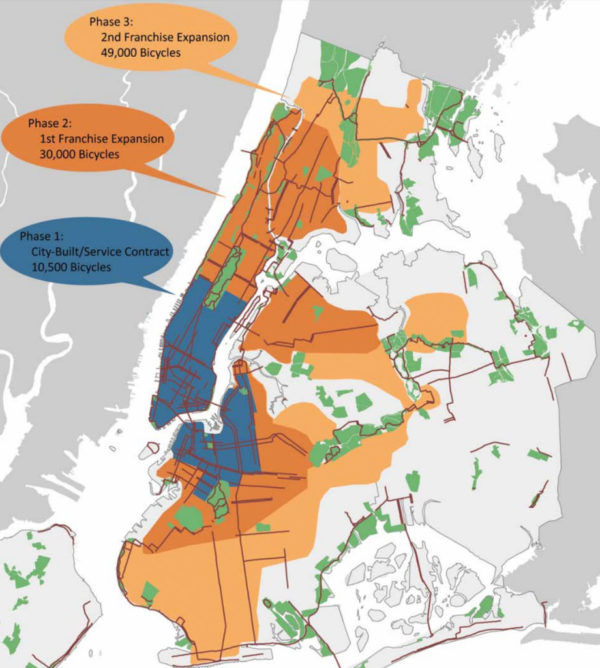The campaign for a more expansive bike-share network is on. Earlier this week, the City Council held a hearing on expanding bike-share citywide. And today, Bronx Borough President Ruben Diaz and Staten Island Borough President James Oddo penned a piece in the Daily News asking for bike-share in their boroughs.
It's great to see all this clamor for bike-share from the city's political class. But the goal of providing good bike-share service to many more New Yorkers would be better served by adopting a more specific framework than five-borough bike-share, which would be expensive to build out and difficult to operate.
Somewhere between blanketing the whole city with bike-share stations and letting the system stagnate at the current plan for 12,000 bikes arranged in central neighborhoods, there's a sweet spot -- building a system in all compact, walkable neighborhoods where bike-share will be well-used.
At the City Council hearing, NACTO Bike Share Program Director Kate Fillin-Yeh said a smart goal would be the above service area, covering neighborhoods with at least 30,000 residents per square mile. That's the population density at which bike-share systems are "likely to be heavily used, a real transportation option, and profitable," she said [PDF].
The map comes from a 2009 feasibility study of bike-share in NYC that Fillin-Yeh co-authored for the Department of City Planning [PDF].
There are several advantages to a system of this size. It would be more achievable than covering the city with 80,000 bike-share bikes. The system could still be run efficiently, without worrying about subsidizing low-ridership areas in NYC's suburban fringes. While it wouldn't reach Mill Basin and Bayside, it would serve a large proportion of lower-income neighborhoods like East Flatbush, Brownsville, Corona, and Soundview. This coverage map is equitable.
We don't have access to Citi Bike's financials, which makes it hard to know how much turf Motivate could cover without an operating subsidy. But there are good reasons to believe that once the upfront costs of system expansion are paid for (which, to be clear, would probably amount to a few hundred million dollars for an area this size), the company could run a bike-share network extending deep into the Bronx, Queens, and Brooklyn without much outside assistance.
Namely, neighborhoods like Park Slope have lower population densities than neighborhoods in the South Bronx. If the city does its job by making streets safer with protected bike lanes, and Motivate does its job via effective marketing and outreach, says Fillin-Yeh, there's no reason Mott Haven should be less hospitable to bike-share than Greenpoint.
In her testimony, Fillin-Yeh identified four key factors to success at this scale:
- A political and technical commitment to a walkable, convenient, dense station network spread over a large, contiguous area.
- The commitment of City resources to match the bike share service area with protected bike lanes.
- Funding, from both from the City and the Operator, for long-term partnerships with local groups, targeted marketing campaigns, and employment programs that hire local residents.
- Progressive pricing options that simultaneously recognize that bike share is the cheapest form of transit available, while also developing mechanisms to expand access to those at the lowest income levels.
This service area does leave out Staten Island, which is a tough fit for bike-share because most of the borough is not dense, it's geographically isolated from the rest of the system, and safe streets for biking are in short supply. If Oddo takes steps to create a safe bike network on the island, maybe a separate contract on the Jersey City model could make sense for Richmond.
For the rest of the city, this four-borough, 49,000-bike system is the bike-share map to shoot for.






